You are being watched!
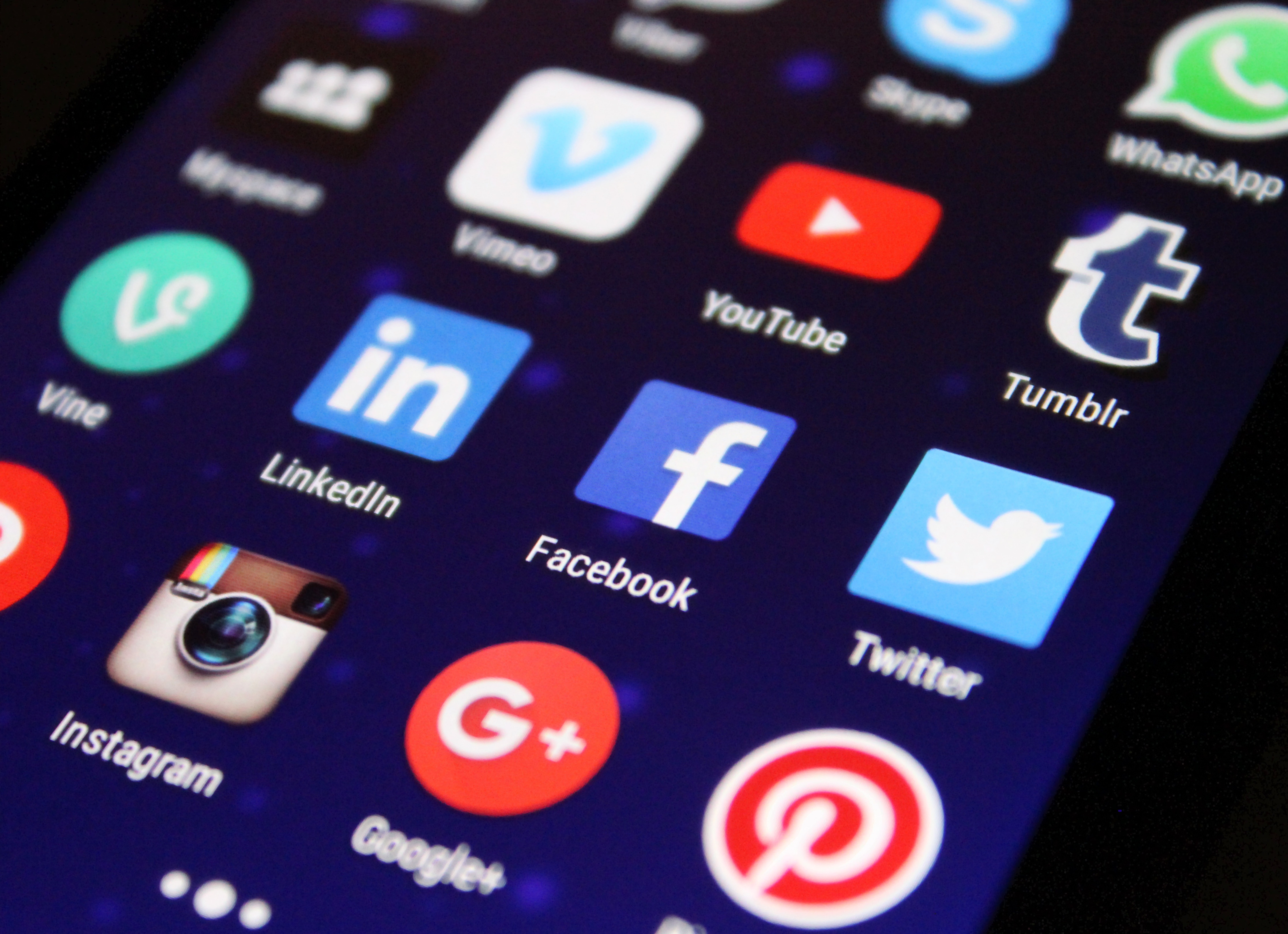
Social media has become omnipresent and we (un)intentionally leave increasingly more information about ourselves: our opinions, habits, interests and beliefs.
The president of the United States is famous for being an avid Twitter user. He is swift to express his opinion directly in a sometimes very raw manner.
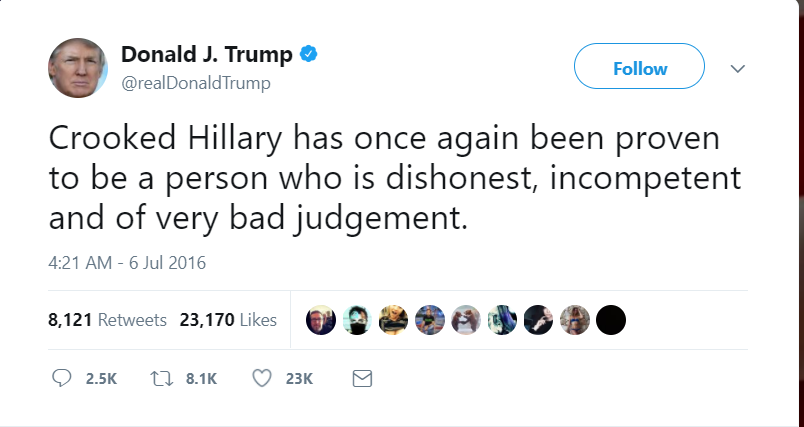
This habit of regular commenting on events and persons is a good opportunity to ask: what insights can we gather from 140 characters of typed by POTUS?
Why POTUS Tweets?
The President of the United States is a person with great power and control over the events in the world. He is a representative of the state which is one of the major players in world stability: peace, economy, science and developmet among others.

With great power comes great responsibility, as the president should represent a role model for the nation, while being under constant scrutiny of public and media. Donald Trump's Twitter feed represents an unique insight into mindset and opinions of a leader of a nation and a successful businessman. Without hesitation and careful diplomatic consideration he is posting his opinions freely. In that freedom we also find inspiration to explore what might he reveal about himself and find out more about @realDonaldTrump.
Data has it all
What we publish on the Web does not disappear. This is a very important consequence for social media and our online presence. Even if we seemingly delete an unfortunate image or post, chance is, it is still stored somewhere. This is emphasized to the extremes in cases of celebrities and people of power, such as Donald Trump. Here we see a famous gaffe: a late night "covfefe" tweet. He has deleted the Tweet afterwards, but it was already too late - everyone was talking about it.
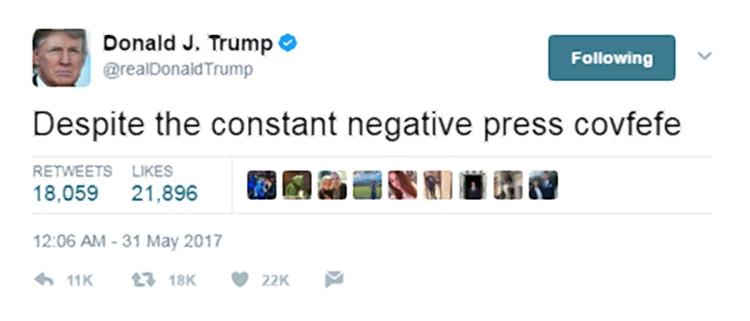
In a similar fashion, Tweets are directly accessible to the public. Our opinions from many years, or a late night rant or drunken post - it is saved somewhere. This is only one example of information we leave online: interactions, logs, likes and different metadata is also present to represent our online identity.
We will use the public availability of Donald Trump tweets to gather some insights on his use of Twitter, his habits, reactions and sentiment throughout the years. Moreover, we will look from different approaches his reactions to the news articles about him or his cabinet in the White House.
Who posts from @realDonaldTrump
Donald Trump is a businessman, celebrity, media personality and a president. From the emergence of his Twitter account in 2009. he has posted many tweets, but it is certain that he has social media managers for elements of his media presence.
The majority of the tweets were posted from Android, which is a device of choice for mr. Trump. We can see other utilities, such as iPhone or Web Client being prominent as well. Since Donald Trump has been noted to rarely use computers we can for now assume the posts he made are originating from Android. That is a significant amount of Tweets that are approved, but not directly penned by Donald Trump.
Since becoming POTUS, many concerns were raised for using an insecure Android device. Thus, Trump has switched to iPhone. This is visible from the Twitter data as well: the last Tweet posted from Android is on 25th of March, 2017, keeping his promise of using a more secure device. Seeing that iPhone has been used before as well in parallel, it could be either his social media maganers or himself.
User engagement
How did becoming a POTUS change the landscape of interaction of users with his Tweets? Let us find out! We count favoriting a tweet and retweeting different metrics of level of interaction.
It is evident that since declaring candidacy on June 16th, 2015, his Twitter account has seen a steady increase in interactions - signs of undergoing campaign and supporters flowing in. A sharp peak can be seen in November 2016 - exactly when the US presidential elections that Trump won took place.
Comparing the devices used to post: Android and iPhone, we can observe slight differences.
If we consider Trump using his Android phone until March (when there is a halt from that device), iPhone has been used
presumably by his social media and campaing managers to promote him as a candidate.
In general more popular tweets have come from Donald Trump himself, notable popular examples suggest presidential victory.
and inauguration as important events, besides other peaks that can be observed.
After March 2017, it is more difficult to track the author
solely by relying on the presumption of the device used.
Tweets popularity
Analysing the social-media platform interactions is a two way street as we can take into consideration,
on the one hand the author and, on the other hand, the followers that engage with the tweets.
There are two quantifiable forms of involvement with one's tweets of their followers recorded in our data:
favorites count and retweets count. Out of these two, we consider the favorites count more insightful as
it reflects the appreciation of the users.
Let's take a look into the details of the most popular tweets of Donald Trump comparing three periods:
- Before presidential candidacy announcement
- During the candidacy
- After winning the election
But first, let's define popular as being in the top 10% of the most liked tweets in that period.
As expected, given the periods span over different timeframes, 10% of each represents a different value, but as mentioned before, since becoming a candidate for the White House, there is a lot more activity on his account.
Tweets entities analysis
Do these tweets present interesting patterns to why they gathered the appreciation? We can try to find that out by first looking at the hashtags and user-mentions in them.
We can remark that Trump's followers engaged the most with tweets containing his campaign slogans and mentions to his opponent,
while the tv-shows-related hashtags from before dissappeared from his top tweets.
Now we can take a look at the user mentions in these tweets.
Shifting our focus to the user mentions during the candidacy period, we observe that the twitter-handle
with the highest count in the top 10% of the most popular tweets is @realDonalTrump himself.
This is explained by the fact that these are retweets and, being between the most favorited ones,
his followers do appreciate them significantly.
As they are all supportive tweets, one reason for them being in top 10% would be that his followers
appreciate, most importantly, seeing Donald Trump engaging with his community.
As a pattern that can be observed in the user mentions is that in every period there was a proeminent subject in his most popular tweets:
Barak Obama in the pre-candidacy time frame, Hilary Clinton and a few news outlets during his candidacy and
news outlets in principal since after the election.
Vocabulary insight from the top 10% most favorited tweets
Earlier we only looked at the hashtags and user mentions which, to some extent, are representative for the tweets.
We now want to have a more detailed insight into the words he uses in the tweets that resonate the most with his followers.
Hence, applying the same procedure as with the entities, we can visualize in a separate word-clouds
what words make up his most popular tweets.

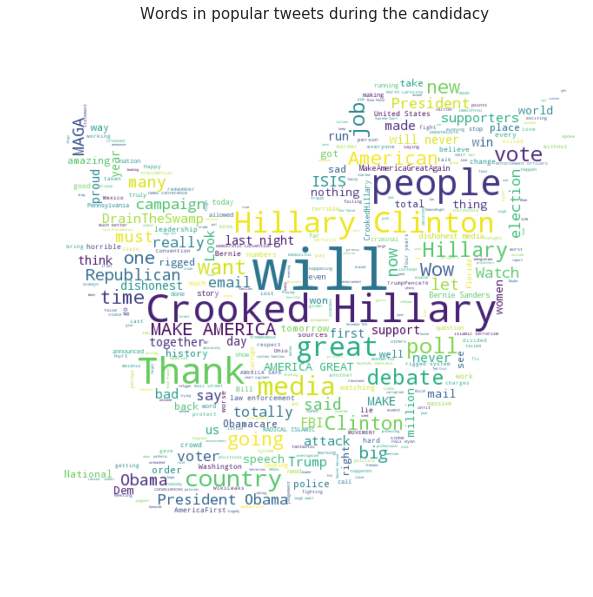

There is rather no surprise: the same tendencies of a proeminent subject, that we noted while analysing the hashtags and user-mentions, we can also observe it at the level of words he uses.
Part-of-speech based vocabulary insight
Firstly, the visualization above, even though is split by period, it is rather coarse-grained and we are wondering, what if there are more insights if we look at most popular tweets with other glasses. Specifically, what could we observe if instead of splitting the tweets by period, we just take the top 10% most liked ones and group them by the part-of-speech they represent. Let's see below, what this gives us!

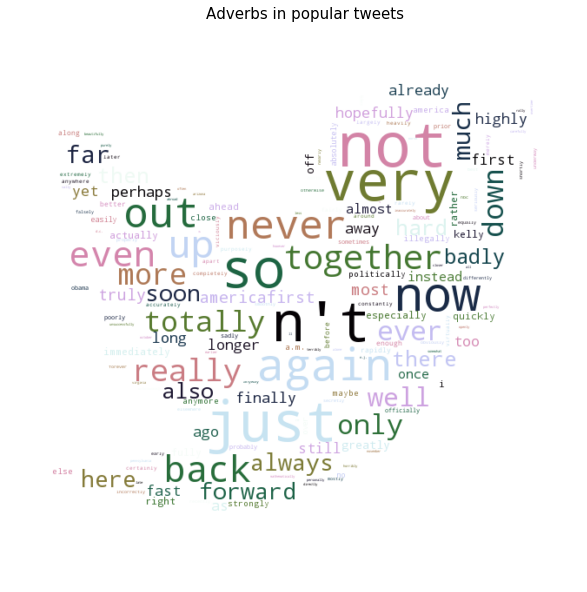
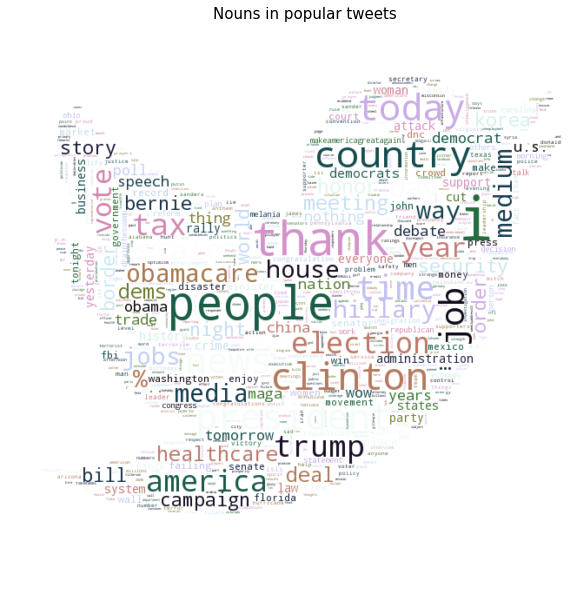

Our hunch proved to be fruitful! Having this view over the 10% most liked tweets gives us a better insight into the words he uses. Looking at the verbs, the most common ones are be, do and have which appeal to the basic aspirations of a human being. Also noticeable is the high usage of the adverb very which denotes a rather simplistic language that is welcomed by his followers. This, on the other hand. allows him to emphasize his point of view in a fairly easy way.
In order to not influence the reader towards some specific insight, we leave the two other parts of speech to be freely analysed and we continue to the next section.
In the news: Trump and his Administration
Being a public persona, businessman and politician has enabled Trump to leave his mark on the news:
interviews, reports and a variety of press coverage.
We can gain an insight on what has Trump opinionated on strongly enough that it has managed to reach the news.
From businessman and a TV personality to politician and president - we can gain insights on interests and critique
of Donald Trump and his closest associates. This can also give an insight on his political agenda, as well as
shed light on issues that either trouble his presidency or he actively tackles.
News topics over the years
A historical insight shows the best the evolution of interests of Donald Trump, reflected in the news. From 2009 when the data has been first collected, we can observe that number of topics has been growing over time: Donald Trump engaging more into public life besides entertainment. Likewise, the variety of topics is increasing as well, - close with his political or personal agenda.
What is this administration about?
News cover not only the statements of politicians, but also provides a critique and other reports in connection to them.
One such example is the Russian-ties investigation
or some legal issues that have been brought up.
We show the top 20 topics in the news that have appeared since Donald Trump taking office in 2017.
We can see the political agenda clearly: immigrants and homeland security being the first topic, while crime and Russia also take a significant place in the distribution of the news topics.
What is in the news on certain tweet topics?
Since his Twitter feed is a free outlet of his thoughts and opinions, we are interested if we can observe certain trends
in reaction to the topics of the news. Social media and social herding has a very powerful effect Trump must be aware of,
can we observe if he uses his online voice to strengthen his position among his followers and create a context that
is different from the news reports.
We will look into what topics are in the news when he tweets about certain topics: hashtags, mentions or simply parts of tweets
that containt a defined phrase.
Fake news?
Fake news has become an infamous term used by Donald Trump frequently to discard news and lable media outlets as "fake". These reactions are usually to news coverage that is not benevolent towards policies and critique his stances and appriaches. We can notice that "fake news" has emerged since end of 2016 - just about when he was to take the office as POTUS. The frequency has been relatively spread out, with certain significant mentions from the news appearing on the days with most frequent "fake news" tweets:
- September 30th 2017 - criticism on Puerto Rican hurricane response and Alabama preliminaries.
- August 7th 2017 - 200 days of Trump Administration
- May 28th 2017 - Montana special Congressional race
After we have localized the tweets containing "fake news" as a topic, we will show what topics in the news occur in the immediate time period of 1 day after publishing such tweets.
To see whether the news topic has been significant, we will also check all the news topics 5 days after the publishing of the "fake news" tweets, in practical terms - what is the more average distribution of news in that period.
From this naive approach, we can pair up the news from 1 and 5 day intervals - to try to filter out the regular news
that might not be targeted by his tweets. With this approach no formal conclusions can be made.
Another "intuitive" but thus possibly wrong conclusion might be that unmatched long term topics are actually targeted
by such tweets, in this case: Ethics, Military, Climate Change, Foreign Policy and Environment.
We do not have the expertise to test the hypothesis in such settings (news and social sciences). One of the presumptions
and hypotheses could be that he is using "fake news" to diminish the effect of certain topics and media outlets by targeting
them on purpose. However, we did not test this hypothesis yet.
And his opponent "Crooked" Hillary?
What does appear in the news when Hillary Clinton, his political oponent, is mentioned. Having very strongly expressed
his opinions of Hillary, along with calls for her imprisonment, can mentioning her be a scapegoat for some burning issues for Trump?
We can see especially numerous mentions during the campaign, peaking just before the elections, then significantly dropping in frequency.
Long term unpaired topics are: Campaign Finance, Transparency, Legal Issues and Criminal Justice.
Short term unpaired topics are: Campaign and Ethics.
Without hypothesis test we cannot conclude the significance, but it is peculiar how those topics relate closely
to his agenda about Hillary Clinton.
What about his predecessor, Barack Obama?
Barack Obama is the previous president of the United States. He has been called out by Trump directly on many occasions, infamously
for requests to see his birth certificate to confirm he is a citizen of the USA.
Over the time we can see a very dense distribution of "obama" mentions in the tweets, noticably peaking just before the election night.
In general, he calls him out regularly even after the elections.
Unmatched short term and long term news topics are more prominent here.
- Short term news topics (1 day after the tweet): Campaign Finance, Congress and Veterans.
- Long term news topics (5 days after the tweet): Environment, Trade, Civil Rights and Clinton Emails.
What is in the tweets on certain news topics?
We want to show the opposite now, when selected news topics are aired, what topics are in the Trump's Twitter feed.
This might provide a more detailed insight on what he tweets about, whom he mentions or tags.
Without certainty and formal testing, we presume that such behavior might be about deflecting and diminishing certain topics,
by mentioning provocative topics, calling out his opponents or asserting patriotism.
In news: Russia and FBI
We explore one especially unpleasant set of topics for Donald Trump: Russia and FBI. Displayed are the news occurences over time containing either of two terms.
We display the occurrence of two topics from the tweets appearing up to 2 days after the news airing:
- Mention: CNN
- Hashtag: MAGA (Make America Great Again)
MAGA, CNN - easy response?
Trend of reaction, peculiarity?
We put some of the highest occurrences of tweet topics in context with the news on topics of Russia and FBI as topics:
- Mentions: CNN, DRUDGE_REPORT (Drudge report is an American conservative right-wing news aggregation website)
- Hashtags: MAGA, MakeAmericaGreatAgain
We can observe that after significant number of news topics with Russia, CNN or MAGA is mentioned.
Our presumption is that these responses might be to discredit the news outlets, while enforcing high level of patriotism
in contrast to Russian implications - in order to diminish the importance of the news.
More apparently with FBI news topic, there is a sudden spike in CNN and DRUDGE_REPORT mentions, showing that Trump reacts
directly by referencing right-wing news aggregation website along with CNN.
In order to make direct conclusions, we would have to consult pshycologicsts, news analysts, politicologists and experts in
social media and social sciences to provide a definite conclusion. Based on the data, we show the peculiarities we have observed, along
with our presumptions. It is an insight - not a ground truth or hypothesis.
How does tweets sentiment evolve over time?
In the last part of the analysis, we inspect the tweet sentiment evolution over time. There is the possibility that Trump tried to become a "better person" during the elections period, such that in this way he could win the hearts of the voters. Let's see what is the reality, though.
Using Google Natural Language API
In order to assign a sentiment to each tweet, we used the Google Natural Language API for
Sentiment Analysis. The API computes a score
between -1 and 1 for each tweet, -1 being assigned to a very negative tweet and 1 to a positive one.
Having these scores, it is interesting to see how is the average sentiment of Trump's tweets evolving over time:
As the attentive reader might observe, there are two consistent decreasing trends in the plot: one around 2012, and the other around 2016. Considering the political context during these two periods, one might find that, during the two aforementioned years, presidency elections took place in the US.
Using statistics for validating hypothesis
In the light of the previous information, a hypothesis becomes more and more probable: is it possible that Donald Trump uses negative
tweets to fight against the opposition during elections? For validating the hypothesis, we first need to perform a statistical test
on the available data.
Applying a student t-test, we can find p-values lower than 0.001 that confirms that the average sentiment during the elections
period is lower than the average sentiment during the period between the elections.
Further analysis
Anyway, it is possible that the negativity in his tweets might have been caused by other factors other than the presidency campaigns,
and that the correlation is only accidental. We tried to exclude that possibility, by further analysis of the datasets.
For that, we analyzed the most used words in the negative tweets during both presidential campaigns, to see if they are related
to the presidential campaign. The results are presented in the bar plots below:
As we can see, the top 5 words during 2012 campaign include barackobama and obama, which implies that the negative tweets have
been mostly addressed to Barack Obama, one of the presidential cadidates. Also, between the top 5 words during 2016 campaign, there are the
words Hillary and crooked, which he used to refer to his direct opponent, Hillary Clinton.
Results interpretation and conclusion
Therefore, considering all the previous facts, we consider that it's plausible for Trump to use a campaign strategy which involves
attacking his opponents in the media, instead of showing the good aspects of his own person. Even though he did not run for
presidency in 2012, he still attacked Obama during the campaign, probably because he wanted to win the hearts of the voters
before running for 2016 presidency.
With more analysis like this, we can raise awareness among the population about the techniques used by the presidential contestants,
all around the globe. If we want to have a better world, in which everyone tries to improve himself, and not to find faults of the
others, we need to support this kind of behaviour, and to realize that the change starts with ourselves.